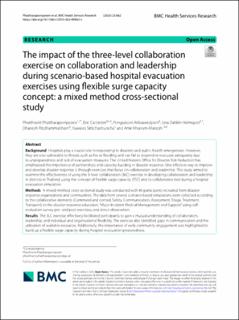| dc.contributor.author | Phattharapornjaroen, Phatthranit | |
| dc.contributor.author | Carlström, Eric | |
| dc.contributor.author | Atiksawedparit, Pongsakorn | |
| dc.contributor.author | Holmqvist, Lina Dahlén | |
| dc.contributor.author | Pitidhammabhorn, Dhanesh | |
| dc.contributor.author | Sittichanbuncha, Yuwares | |
| dc.contributor.author | Khorram-Manesh, Amir | |
| dc.date.accessioned | 2024-03-21T10:02:43Z | |
| dc.date.available | 2024-03-21T10:02:43Z | |
| dc.date.created | 2023-09-04T14:30:47Z | |
| dc.date.issued | 2023 | |
| dc.identifier.citation | Phattharapornjaroen, P., Carlström, E., Atiksawedparit, P., Holmqvist, L. D., Pitidhammabhorn, D., Sittichanbuncha, Y., & Khorram-Manesh, A. (2023). The impact of the three-level collaboration exercise on collaboration and leadership during scenario-based hospital evacuation exercises using flexible surge capacity concept: a mixed method cross-sectional study. BMC Health Services Research, 23(1), Artikkel 862. | en_US |
| dc.identifier.issn | 1472-6963 | |
| dc.identifier.uri | https://hdl.handle.net/11250/3123574 | |
| dc.description.abstract | Background: Hospitals play a crucial role in responding to disasters and public health emergencies. However, they are also vulnerable to threats such as fire or flooding and can fail to respond or evacuate adequately due to unpreparedness and lack of evacuation measures. The United Nations Office for Disaster Risk Reduction has emphasised the importance of partnerships and capacity building in disaster response. One effective way to improve and develop disaster response is through exercises that focus on collaboration and leadership. This study aimed to examine the effectiveness of using the 3-level collaboration (3LC) exercise in developing collaboration and leadership in districts in Thailand, using the concept of flexible surge capacity (FSC) and its collaborative tool during a hospital evacuation simulation.
Methods: A mixed-method cross-sectional study was conducted with 40 participants recruited from disaster-response organisations and communities. The data from several scenario-based simulations were collected according to the collaborative elements (Command and control, Safety, Communication, Assessment, Triage, Treatment, Transport), in the disaster response education, “Major Incident Medical Management and Support” using self-evaluation survey pre- and post-exercises, and direct observation.
Results: The 3LC exercise effectively facilitated participants to gain a mutual understanding of collaboration, leadership, and individual and organisational flexibility. The exercise also identified gaps in communication and the utilisation of available resources. Additionally, the importance of early community engagement was highlighted to build up a flexible surge capacity during hospital evacuation preparedness.
Conclusions: the 3LC exercise is valuable for improving leadership skills and multiagency collaboration by incorporating the collaborative factors of Flexible Surge Capacity concept in hospital evacuation preparedness. | en_US |
| dc.language.iso | eng | en_US |
| dc.rights | Navngivelse 4.0 Internasjonal | * |
| dc.rights.uri | http://creativecommons.org/licenses/by/4.0/deed.no | * |
| dc.title | The impact of the three-level collaboration exercise on collaboration and leadership during scenario-based hospital evacuation exercises using flexible surge capacity concept: a mixed method cross-sectional study | en_US |
| dc.type | Peer reviewed | en_US |
| dc.type | Journal article | en_US |
| dc.description.version | publishedVersion | en_US |
| dc.rights.holder | © The Author(s) 2023. | en_US |
| dc.source.volume | 23 | en_US |
| dc.source.journal | BMC Health Services Research | en_US |
| dc.source.issue | 1 | en_US |
| dc.identifier.doi | https://doi.org/10.1186/s12913-023-09882-x | |
| dc.identifier.cristin | 2172168 | |
| dc.source.articlenumber | 862 | en_US |
| cristin.ispublished | true | |
| cristin.fulltext | original | |
| cristin.qualitycode | 2 | |

